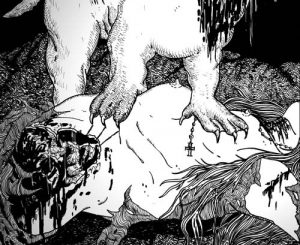Turnip Lanterns
Long before carving pumpkins became a staple of Halloween there was a tradition of carving turnips to create lanterns on the 31st of October. These lanterns were left overnight on gateposts, doorways and in windows in many parts of Britain. They were also attached to long poles as part of the festivities ,paraded around town and thrust before high windows to frighten the occupants, part of the tradition of trickery on this date.
 These lanterns represented the spirits of the dead and are the origin of the pumpkin lanterns that are now part of the Halloween festivities. The use of a pumpkin stems from when the tradition passed to America, where pumpkins were available, and, easier to carve out than turnips. One theory is that it is an Irish tradition, moving to America with Irish immigration in the 19th Century. The tradition is also found on the Isle of Man and in Scotland.
These lanterns represented the spirits of the dead and are the origin of the pumpkin lanterns that are now part of the Halloween festivities. The use of a pumpkin stems from when the tradition passed to America, where pumpkins were available, and, easier to carve out than turnips. One theory is that it is an Irish tradition, moving to America with Irish immigration in the 19th Century. The tradition is also found on the Isle of Man and in Scotland.
 I have talked to quite a few people who remember carving out turnip lanterns when they were children and with this in mind I decided to give it a go with help from my 4 year old son. A trip to the shops soon led to the discovery that there must be a world shortage of turnips as I had to settle for a swede, close enough I suppose although much smaller than a turnip.
I have talked to quite a few people who remember carving out turnip lanterns when they were children and with this in mind I decided to give it a go with help from my 4 year old son. A trip to the shops soon led to the discovery that there must be a world shortage of turnips as I had to settle for a swede, close enough I suppose although much smaller than a turnip.
After getting it home I soon discovered why pumpkins have replaced the turnip: the inside is rock hard and the usual spoon carving was not going to get me anywhere (unless it had a razor edge, which would make it a bit of a liability as a spoon).
 As luck would have it I still had a few tools left over from wood carving days, in particular a couple of gouges, which are semi circular chisel used for carving depressions in wood. This made the carving a bit easier but it still took about 20 minutes. You can get bent knives for carving bowls and one of these may have been the perfect tool if I had one.
As luck would have it I still had a few tools left over from wood carving days, in particular a couple of gouges, which are semi circular chisel used for carving depressions in wood. This made the carving a bit easier but it still took about 20 minutes. You can get bent knives for carving bowls and one of these may have been the perfect tool if I had one.
After carving out the inside I set about drawing the pattern on the outside, ably helped by my son (as he couldn’t really help with the carving) which I then cut out with a sharp knife. Once the inside has been carved the rest of the process is no different to creating a pumpkin lantern although obviously on a much smaller scale (especially with a swede).
 One word of warning though there may be good reason they were left outside overnight: after getting warm with the candle inside they really stink, I am talking rotten cabbage stench here, so the lantern was quickly consigned to the back step. The odd thing was it was gone in the morning, hopefully not to return on Halloween.
One word of warning though there may be good reason they were left outside overnight: after getting warm with the candle inside they really stink, I am talking rotten cabbage stench here, so the lantern was quickly consigned to the back step. The odd thing was it was gone in the morning, hopefully not to return on Halloween.




Re: Turnip Lanterns
[quote]The odd thing was it was gone in the morning, hopefully not to return on Halloween.[/quote]
I hope your not making a paranormal claim there Daniel. Who would want to steal a smelly turnip? Where do you live and what are your neighbours like?
Re: Turnip Lanterns
I remember making these as a child in Staffordshire, we used to pop over the farmers field, avoiding the witches corner( haven’t a clue how it got it’s name but all the kids new it) and collected the turnips fresh.. luckily we never got caught lol
Re: Turnip Lanterns
I do recall hearing about turnip lanterns but cannot remember from where or more info other than it was before the use of pumpkins.
It would probably take me hours to try and carve my way through one so I think i’ll just stick with a pumpkin especially now I know of the smell issue. However good luck to anyone who gives it a go.
I am very impressed with above example Daniel :0) Well done!
Re: Turnip Lanterns
I think they still make these on the Isle of Man.
Red Don I am guessing an animal took it, although what animal would want a smelly swede is anyones guess.
Re: Turnip Lanterns
I remember trying making one when I was much younger and ending up making a complete mess of it.
In Distortion We Trust
Re: Turnip Lanterns
As a kid, we used to make turnip lanterns, moreso because pumpkins seemed hard to come by then for some reason(though I do recall at the time seeing illustrations of jack o’ lanterns, particularly from American sources, that showed pumpkins).
Suggestions for the tradition have made mention of Celtic Head Cults, and also the Samhain fires to which the hungry dead may be drawn. The carved vegetable heads, initially not being a celebration of the spooky but intended to ward off malign spirits.
A tip for carving pumpkin lanterns is not to cut entirely through the skin, but to leave a layer of white pith intact, then when the candle is lit inside, the effect is much improved.
@ndy
Re: Turnip Lanterns
We should have arranged a Turnip Lantern competition. Maybe next year
Re: Turnip Lanterns
A SWEDE is a TURNIP! I’ve been arguing this for 20 years with southerners. We used the ones my grandfather grew on his allotment (not that we told him!)
Exactly!
Re: Turnip Lanterns
I forgot to mention this. I the North-East we burned them on the bonfire on 5th November. By this time they had dried out and burned beautifully. My dad always had HUGE blisters on 1st November, which probably took all year to heal!
Re: Turnip Lanterns
"A SWEDE is a TURNIP! I’ve been arguing this for 20 years with southerners. We used the ones my grandfather grew on his allotment (not that we told him!)"
I was wondering the difference was, they offer both at Tescos, but the turnips were tiny the ones on this website:http://www.iomtoday.co.im/news/Fighting-back–traditional-style.4619125.jp
look a better size or are they swedes, now I am confused.
The one I carved turned up under the hedge, perhaps it was trying to make it to the gatepost
Re: Turnip Lanterns
Hee hee,
Yes we always had one when I was a kid.
By the time I turned ten or so, I was given the uncarved swede myself and left to go at it with whatever I could find best in the drawer. Because it’s hard inside, it’s tricky with an ordinary knife not to cut the outer skin, or indeed yourself. I learned somehow, I think I developed a method, cutting deep cris-crosses and getting the squares out, layer by layer.
The advantage with these is that they’re usually tough enough to put some string or thick wire in like a handle, and carry, whereas pumpkins from shops are softer. The pumpkins I grew one year were slightly harder than standard shop ones, coz I think I’d followed Peter Seabrook’s instructions to let it weather a bit once cut from the plant, and the weather will harden the hide.
What was that story on Jackanory way back, about a village in Scotland was it, and the final scene was everybody ended up with glowing Jack o’ Lanterns on their cottage doors?
The DVD "Pumpkin Moon" is a nice little story for Hallowe’en, too. Hee hee, there’s a special added feature hosted by some crazy puppet, showing you how to make all kinds of Blue Peter style props and figures for Hallowe’en!
Re: Turnip Lanterns
Me and my family still make em. Very difficult though, you have to be quite skillful with the knife or you are at threat of getting cut!
Re: Turnip Lanterns – the Isle of Man tradition – of Hop-Tu-Naa
Hop tu naa is Manx for Halloween, it means the same as hogmanay, means new year, as the 1st november was the start of the celtic new year. Pronounce it ‘hop-chew-nay’
(nay as rhymes with say)
Drilling out the turnip-
Nowadays people mostly use an electric drill with appropriate fittings a nice wide bit to drill out the inside, and a smaller one for the chimney, and smaller again for the string holes.
http://www.manxnationalheritage.im/whats-on/detail/ace-event-turn-up-for-turnips/
The modern hop-tu-naa song (Douglas version)
http://en.wikipedia.org/wiki/Hop-tu-Naa